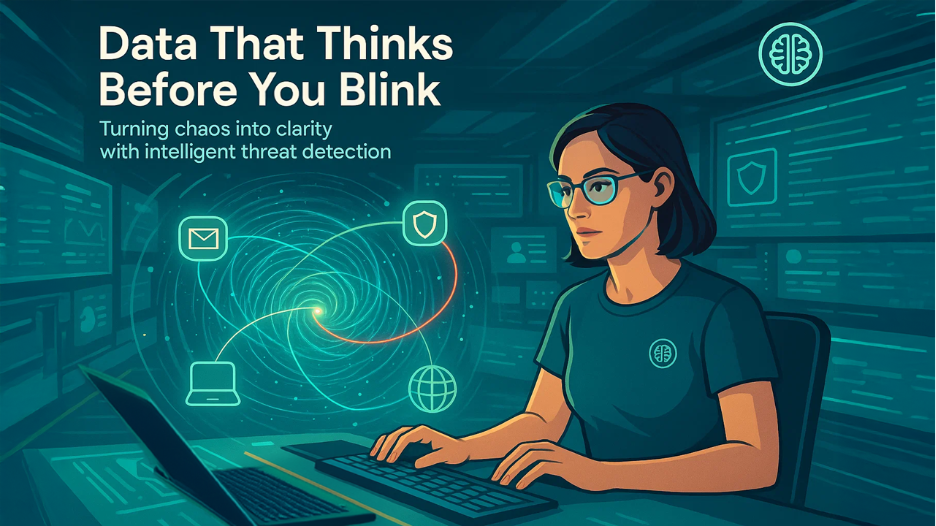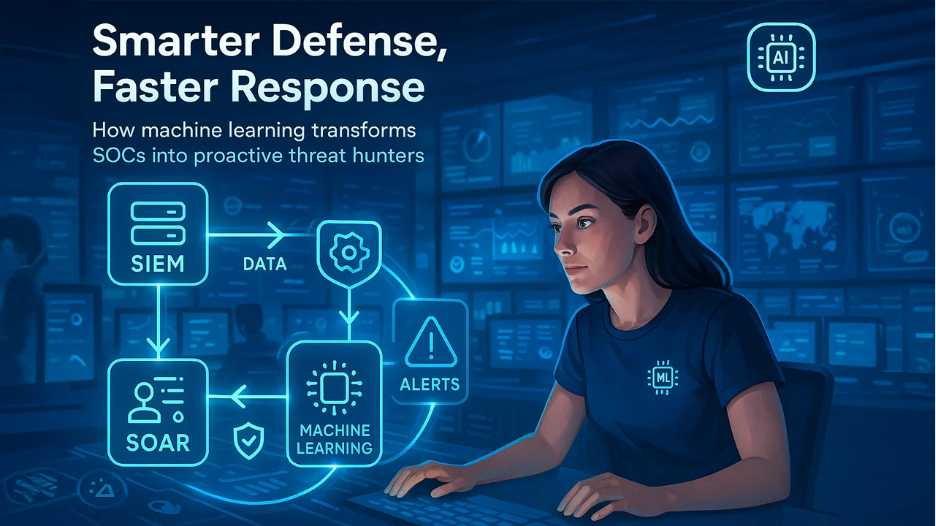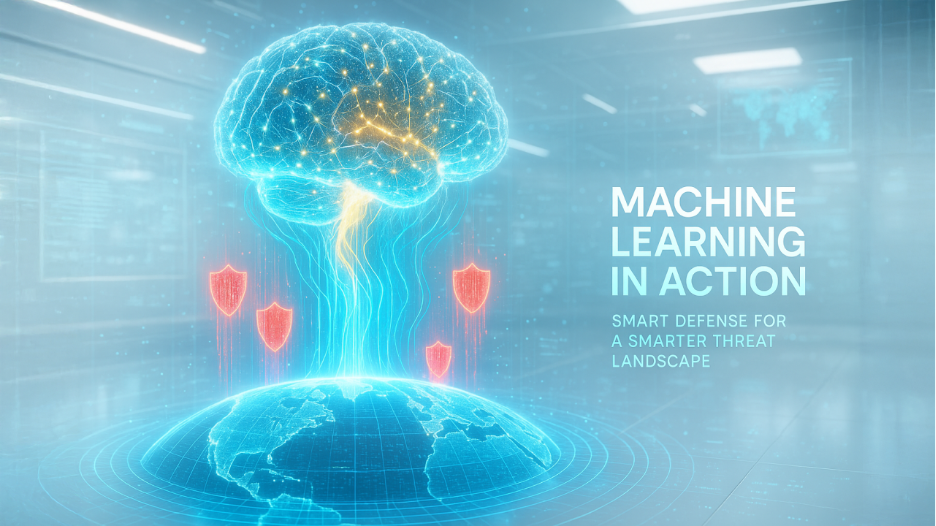Cyber threats are getting smarter, faster, and unpredictable by the day. That's where machine learning steps in-it doesn't just react, it learns and adapts. It analyzes patterns, behaviors, and data
Cyber threats are getting smarter, faster, and unpredictable by the day. That's where machine learning steps in-it doesn't just react, it learns and adapts. It analyzes patterns, behaviors, and data at scale to keep security systems one step ahead. To put it simply, machine learning is redefining the way modern threat detection works.
How Machine Learning Transforms Cybersecurity
Machine learning changed the approach of cybersecurity teams to detection and prevention. Instead of systems with long lists of predefined rules, now they learn from real-world attack data and adapt over time. This means that, even if hackers change their tactics, a system can still recognize suspicious behavior and respond faster than any human could.
According to VirtualArmour,experts, another critical advantage in machine learning is the fact that this technology removes the need for constant human supervision. While an analyst would take hours noticing an anomaly, machine learning scans thousands of data points in a second. This automation helps reduce human error and ensures that no red flags fall through the cracks, especially on high-traffic occasions.
You can also see the difference in predictive capability. Traditional methods are all about responding to attacks after they happen, but machine learning foresees them before they cause any damage. It analyzes past threats, spots repeated trends, and gives teams insight on how to plan for similar future attempts. It's almost like upgrading from security cameras to a guard that can read intentions.
Machine learning serves to optimize decision-making for cybersecurity professionals. Instead of flooding analysts with endless alerts, it weeds them out and prioritizes them-so experts know which ones deserve attention and which ones don't. The technology doesn't replace the human element; it makes them act wiser, faster, and with more confidence when repelling ever-sophisticated attacks.
Real-Time Detection of Unknown Threats
Perhaps most impressively, machine learning has the power to detect zero-day attacks-those new, unseen threats that haven't been cataloged yet. Because these models analyze behavior rather than rely solely on known malware signatures, they can flag unusual patterns that signal an attack in progress before it's officially recognized.
Real-time detection is no longer dependent on static rule sets. Through machine learning, it's constantly learning from the environment by comparing live data against norms from the past. If it detects something out of character, such as a sudden spike in file transfers or unusual login attempts, it triggers immediate alerts to security teams so they can respond in moments, not hours.
Another key benefit is adaptability. Cyber threats are not static; they develop on a daily basis, and without updates, old systems just can't handle them. Machine learning models automatically evolve through learning from each new piece of data. That means they're never outdated but continuously improving, sharpening their accuracy after every analyzed threat or anomaly detected.
Finally, these systems increase the organization's visibility into complex and distributed networks. Whether it is cloud infrastructure, IoT devices, or remote servers, machine learning binds them together. Security teams will see how each of these components interacts, thus helping identify threats as they move laterally through systems-a task very hard to handle with manual management.
The Power of Data in Threat Intelligence

Machine learning only thrives on more data, and plenty of it. Each email, each log of connection, and every user action gives insight to help models learn what is normal and what isn't. The more diverse the data, the brighter the system becomes. This creates a system of defense that grows stronger with each analyzed attack and activity pattern.
It's not just about quantity; it's about diversity. Machine learning systems pull data from a variety of sources: firewalls, endpoint devices, web traffic, and even user behavior analytics. Combining all this information creates a complete and more accurate picture of possible threats, reducing blind spots and enhancing detection accuracy across the entire network.
The technology also puts together data that humans could probably not relate to each other. A minor anomaly in login could seem inconsequential until it is put together with an attempt for suspicious network access. Machine learning immediately connects those dots, turning what was previously random signals into crisp, actionable warnings for cybersecurity teams.
The end result is insight: real, usable threat intelligence. Instead of drowning in raw data, companies get refined information they can act on. It enables decision-makers to anticipate problems before they occur and proactively strengthens the weak points in their systems, rather than simply waiting for something to go wrong.
Minimizing False Positives and Alert Fatigue
One of the most frustrating features of traditional security systems is the high frequency of false positives. Machine learning cuts through the noise by learning what normal system behavior looks like. It learns patterns over time and recognizes those that don't pose real threats, thus reducing unnecessary alerts that could waste hours of analyst time.
It also provides prioritization of which alerts should be dealt with immediately. Instead of every small anomaly being treated as an emergency, machine learning models classify events in terms of their importance. Analysts can therefore focus their efforts where it truly matters: addressing actual risks, rather than sorting through hundreds of harmless flags.
Yet another advantage of these models is how they evolve. The more they are exposed to both real and simulated threats, the better they get at distinguishing between safe and dangerous activity. Through periodic retraining, the systems remain accurate and reliable even as the ambient environments, users, and technologies alter.
Ultimately, this frees up security teams for more strategic work. Rather than drowning in an endless tide of notifications, analysts can think about long-term strategy, systems improvement, and proactive defense. Machine learning turns reactive firefighting into forward-thinking protection—and that’s a huge leap for cybersecurity efficiency.
Integration with Security Operations Centers (SOCs)

Machine learning has become the backbone for modern SOCs. The very base of these centers is highly dependent on automation; integrating machine learning makes every process more efficient. Using tools such as SIEM and SOAR allows analysts to see the complete picture of their security infrastructure's activity in real time.
Automation plays a big role here. Instead of manually triaging each alert, machine learning tools can identify those that merit attention instantaneously. This saves not only time but also cuts down burnout and frees up security teams to delve into deeper investigations. The SOC is less about repetitive work and more about smart, data-driven action.
Machine learning also makes monitoring possible for large, complex organizations. It processes billions of data points daily, a far greater number than any human team could process. When suspicious behavior crops up, the system instantly highlights it, usually before anyone even realizes something is awry. The speed at which this happens provides a critical advantage in the response of SOCs to changing threats.
What really makes it powerful, however, is that it learns constantly. Every time an attack is detected and stopped, the system picks up something new. It applies those lessons to the next incident, so detection becomes faster and more accurate over time. That combination of automation and continuous learning makes SOCs far more resilient than they've ever been.
Wrap Up
Machine learning has transformed threat detection into a science of proactivity rather than mere guessing. It helps organizations catch what others miss, learn from every event, and react with speed and precision. In a world full of digital risks, this intelligent approach isn't optional; it's essential.
Related Posts:
Dihward: The Visionary Platform Shaping Digital Identity and Innovation
How to Stay Safe from Social Engineering Cyber Threats
Respond to this article with emojis






